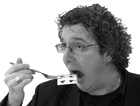Leech's Legacy
Leech, Al
Magic, Inc.
(Based on 1 review)

Reviews
(Top ▲)
I can tell I would have liked Al Leech -- grounded, real-world, smart, but humble, and no doubt very funny. All of this comes through in his writing, and perhaps never more clearly than in his last book, Al Leech's Legacy.
Published in 1980, right about when Paul Harris's influence was becoming widespread, Al Leech's Legacy is a 124-page collection of close-up and stage magic ranging from older pieces that were in Al's act for decades, to newer creations that appear to have had him jumping on the "novelty" bandwagon of the time.
Unfortunately, while this collection is intelligently written, sprinkled with pertinent anecdotes and information, on the whole, the tricks range from fair to just plain bad, though there are a few exceptions. Among these is an excellent routine called A Card Trilogy, in which four Aces are repeatedly (and unexpectedly) produced in the context (and at the conclusion) of three other effects. This is Leech at his best, the kind of borderline self-working card magic that is inspired in its simplicity.
Conversely, many of the other close-up routines in the book are plagued by a lack of effect. For example, in Major Surgery, a 5 of Spades is "freely" chosen by a spectator, then returned to the deck, whereupon the magician reveals the 10 of Spades, thinking it to be the selection. The spectator says no, he chose the 5 of Spades, so the magician pushes the 10 of Spades into the deck and a miniature 5 of Spades emerges from the other end. I defy you to tell me what the trick is here. Similarly, in Typographical Error, one red-backed card in a blue-backed deck turns out to be the card a spectator chose just moments before, but it's then shown to be a mini card... so it's NOT the card the spectator chose, just another card that matches it. WHAT'S THE #$@* EFFECT?!?
Of the material Al included that he has been doing for years, the platform/stage magic is unquestionably the most useful. Unmoved by hand-washing techniques, for example, his work on (and with) The Multiplying Billiard Balls is clean, direct and effective (indeed, I believe this to be the highlight of the book). He also describes various thimble-magic techniques that could easily be compiled into a complete routine (personally, I detest thimble magic, but this may be a groundless pet peeve, unfairly based on the fact that my father was killed by a thimble).
Other stage effects include Platform Wild Card, which uses regular cards, not jumbo cards, and employs a clumsy, obsolete glide count that was actually prominent before the development of the now-popular buckle count, most commonly used in Six Card Repeat routines. Leech defends the glide count, but I honestly can't see why -- much of the face of the cards is covered by your hands during the count, and it just looks less natural.
Al also teaches his Three Cards Across, a bare-bones approach that, while functional, might have been more valuable if he had included his presentation, how he manages the audience during the performance, the use of spectators on stage, etc. As it stands, he just rattles off the method and moves on.
So should you buy the book? My advice is this. If you're looking for work on thimble magic or billiard balls, the answer is yes. You will also get an excellent close-up routine (A Card Trilogy) as a bonus. If you're looking for close-up magic, I recommend you pick up a copy of Al's 1953 book, Card Man Stuff and start from there. I guarantee you will be far more satisfied.
David Acer
Published in 1980, right about when Paul Harris's influence was becoming widespread, Al Leech's Legacy is a 124-page collection of close-up and stage magic ranging from older pieces that were in Al's act for decades, to newer creations that appear to have had him jumping on the "novelty" bandwagon of the time.
Unfortunately, while this collection is intelligently written, sprinkled with pertinent anecdotes and information, on the whole, the tricks range from fair to just plain bad, though there are a few exceptions. Among these is an excellent routine called A Card Trilogy, in which four Aces are repeatedly (and unexpectedly) produced in the context (and at the conclusion) of three other effects. This is Leech at his best, the kind of borderline self-working card magic that is inspired in its simplicity.
Conversely, many of the other close-up routines in the book are plagued by a lack of effect. For example, in Major Surgery, a 5 of Spades is "freely" chosen by a spectator, then returned to the deck, whereupon the magician reveals the 10 of Spades, thinking it to be the selection. The spectator says no, he chose the 5 of Spades, so the magician pushes the 10 of Spades into the deck and a miniature 5 of Spades emerges from the other end. I defy you to tell me what the trick is here. Similarly, in Typographical Error, one red-backed card in a blue-backed deck turns out to be the card a spectator chose just moments before, but it's then shown to be a mini card... so it's NOT the card the spectator chose, just another card that matches it. WHAT'S THE #$@* EFFECT?!?
Of the material Al included that he has been doing for years, the platform/stage magic is unquestionably the most useful. Unmoved by hand-washing techniques, for example, his work on (and with) The Multiplying Billiard Balls is clean, direct and effective (indeed, I believe this to be the highlight of the book). He also describes various thimble-magic techniques that could easily be compiled into a complete routine (personally, I detest thimble magic, but this may be a groundless pet peeve, unfairly based on the fact that my father was killed by a thimble).
Other stage effects include Platform Wild Card, which uses regular cards, not jumbo cards, and employs a clumsy, obsolete glide count that was actually prominent before the development of the now-popular buckle count, most commonly used in Six Card Repeat routines. Leech defends the glide count, but I honestly can't see why -- much of the face of the cards is covered by your hands during the count, and it just looks less natural.
Al also teaches his Three Cards Across, a bare-bones approach that, while functional, might have been more valuable if he had included his presentation, how he manages the audience during the performance, the use of spectators on stage, etc. As it stands, he just rattles off the method and moves on.
So should you buy the book? My advice is this. If you're looking for work on thimble magic or billiard balls, the answer is yes. You will also get an excellent close-up routine (A Card Trilogy) as a bonus. If you're looking for close-up magic, I recommend you pick up a copy of Al's 1953 book, Card Man Stuff and start from there. I guarantee you will be far more satisfied.
David Acer









